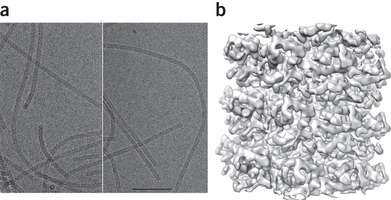Pliable plant virus, a major cause of crop damage, yields its secrets after 75+ years

A hugely destructive plant virus so flexible that it has resisted efforts to describe its form since before World War II has finally surrendered its secrets. The discovery of what makes the bendy bug so malleable will revolutionize the efforts to stop such flexible plant viruses - and the billions in crop loss they cause every year—and may even lead to a new vehicle for delivering vaccines in humans.
"These viruses that infect plants are very, very flexible, and no one has been able to solve the structure of them," said Edward H. Egelman, PhD, of the University of Virginia School of Medicine. Yet Egelman has done just that, revealing the shape and form of the bamboo mosaic virus with the assistance of UVA's mighty Titan Krios microscope buried beneath Fontaine Research Park. The discovery is giving scientists their first look at just how the viruses can maintain their integrity as they bend and flex. Such filamentous viruses are responsible for more than half the viral crop damage throughout the world.
Efforts to stop the viruses have been undermined by a lack of understanding of their elusive design. The viruses are far too small to be seen with a traditional light microscope and so flexible that they resisted efforts to create high-quality models of them via crystallography, the use of X-rays to determine structure at the atomic level. But the bamboo mosaic virus could not escape the scrutiny of UVA's Titan Krios electron microscope, a machine so sensitive that it is buried underground, encased within tons of concrete, to prevent even the smallest of vibrations from disrupting its work. (This is a second victory for Egelman and the Titan in quick succession: Earlier this year, Egelman, of the Department of Biochemistry and Molecular Genetics, attracted national attention after he used the microscope to reveal the form of a bizarre virus that can live in nearly boiling acid.)
Now that the bamboo mosaic virus has been described, researchers can examine its structure to determine how best to stop it and others like it. And they may even be able to harness the virus to stop other diseases. Because the bamboo mosaic virus is harmless to humans, scientists may be to saddle it up to deliver vaccines in people.
"We eat these every day, large quantities of them. Things like cucumbers and potatoes have these viruses, so we have overwhelming amounts of evidence they're not toxic. This means they can be used for platforms for vaccines precisely because they're nontoxic," Egelman said. "But all this work has been hampered because no one has known the structure of them. Knowing the structure is the prerequisite to being able to manipulate them and design new features."

The discovery has earned the cover of the scientific journal Nature Structural & Molecular Biology.
More information: The molecular basis for flexibility in the flexible filamentous plant viruses, Nature Structural & Molecular Biology 22, 642–644 (2015) DOI: 10.1038/nsmb.3054
Journal information: Nature Structural & Molecular Biology
Provided by University of Virginia


















